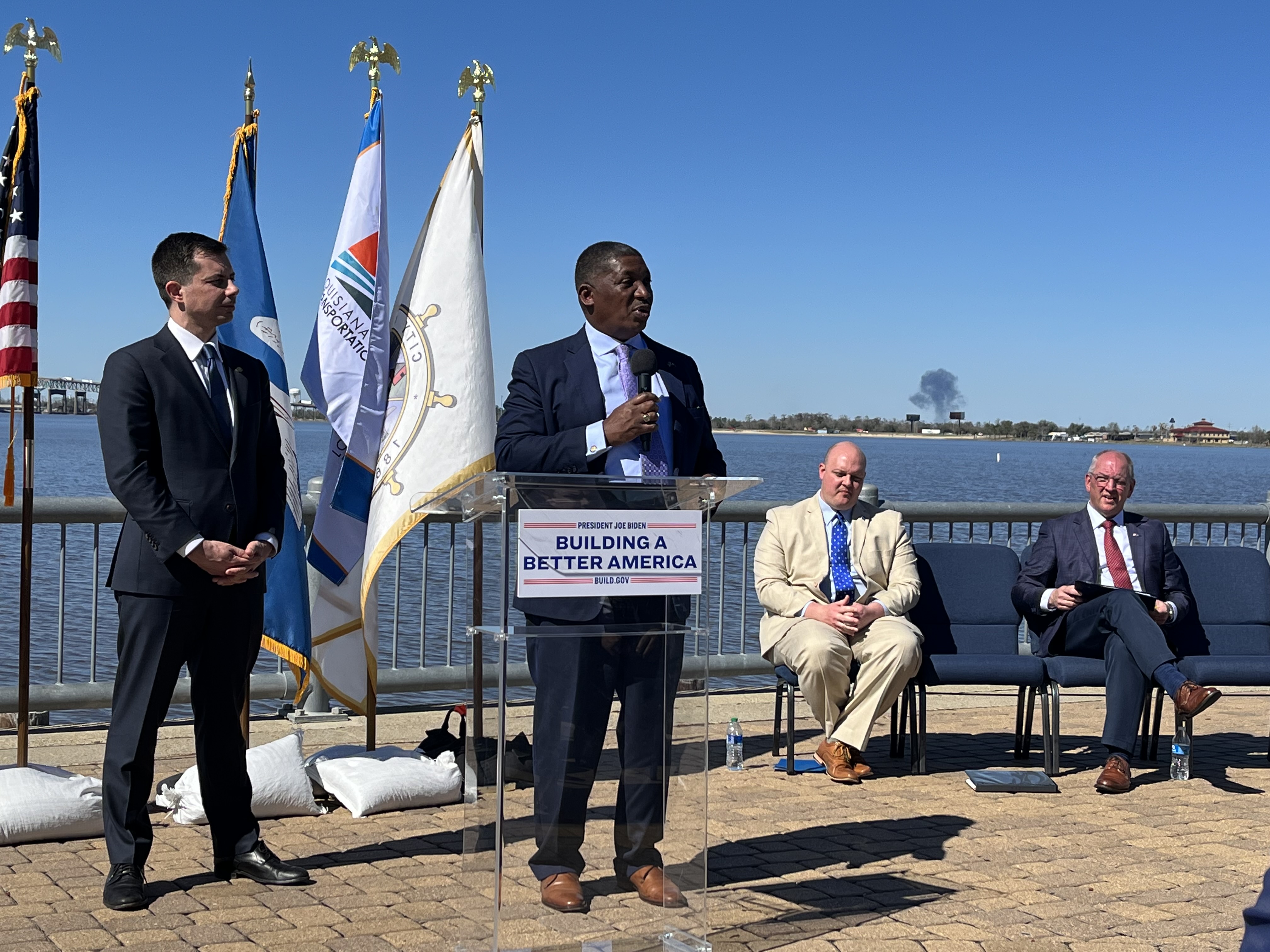‘A light — and a bridge — at the end of that proverbial tunnel’
Published 2:33 pm Thursday, February 9, 2023

- Then-Louisiana Department of Transportation and Development Secretary Shawn Wilson said the estimated $1.5 billion bridge replacement project will extend from the I-10/Interstate 210 west interchange to east of the Ryan Street exit ramp. (Crystal Stevenson / American Press)
U.S. Department of Transportation Secretary Pete Buttigieg was in Lake Charles Thursday to celebrate the recently announced $150 million federal grant for the replacement of the Interstate 10-Calcasieu River Bridge — one of the first major grants out of the five-year Bipartisan Infrastructure Law that is helping to rebuild the nation’s roads and bridges.
“We’re not just building roads and bridges, we’re building livelihoods, we’re building family savings, we’re building those pathways into the middle class that are so important,” Buttigieg said.
Buttigieg said anyone paying attention to American infrastructure knows how important the bridge is not only to jobs, waterfront attractions and the quality of life in Southwest Louisiana but also to a supply chain that impacts the entire country.
“This bridge, as important as it is, is still relying on construction from just after World War II — structurally and functionally deficient today,” he said. “It was built to handle far fewer than the 80,000 daily crossings that are happening and because of the way I-10 narrows from six lanes to four — and a steep four lanes at that — it creates a lot of delays and contributes to a crash rate that’s about 66 percent higher than what is typical in this state.
“If words could build bridges, we would gotten this done a long time ago,” Buttigieg said. “Talk doesn’t build bridges; funding does. Cooperation between different political parties and levels of government does. Our generational moment of investment in America’s transportation infrastructure has to mean a generational investment here in Southwest Louisiana.”
Buttigieg said that over the lifespan of the new bridge it is estimated that people will save more than 115 million hours in travel time. It projected to have 457 fewer crashes because of its wider, less-steep design.
“It’s also going to help with those extreme weather evacuations and allow first responders to get where they need to be more swiftly and more safely,” he said.
Louisiana Department of Transportation and Development Secretary Shawn Wilson said the estimated $1.5 billion bridge replacement project will extend from the I-10/Interstate 210 west interchange to east of the Ryan Street exit ramp. It will reconstruct the Calcasieu River Bridge and the interstate mainline and reconfigure a segment of Sampson Street in Westlake from I-10 to Sulphur Avenue.
The project will provide three thru lanes in each direction to increase traffic capacity and will include flatter curves and wider shoulders.
“In 2016, when this governor took over, we had zero dollars and a 20-plus-year environmental process,” Wilson said. “We had no procurement under way and today we have marked success where we see a light — and a bridge — at the end of that proverbial tunnel.”
Wilson said along with the $150 million mega grant, the U.S. Department of Transportation has approved up to $1.5 billion in private activity bonds toward the bridge’s replacement, which allows for low-interest borrowing for the developers who will be chosen to work on the project.
“This could save them an estimated $100-$140 million, which is going to reduce the overall cost of this project,” Wilson said.
He said there is also $800 million in public funding available from the state of Louisiana to add to the federal contributions as well as $40 million gathered from the Vehicle Sale Tax per year, which will be bonded out over time.
“This was the third-largest mega grant application and because of the timing and the urgency to have a bridge we believe that the model that we pursued in terms of the public-private partnership and the $800 million that we have plus the $40 million a year will give us more that what we need to maximize the ability to keep tolls low on the project.”
Gov. John Bel Edwards said the mega grant — the largest ever received by the state of Louisiana — is designed to benefit major infrastructure projects that will have far-reaching economic impact throughout the region.
“This bridge is 70 years old,” Edwards said. “It’s outdated, it lacks safety features and if there is an accident, because there’s no shoulder, you’re automatically down to at least one lane assuming you can keep that one open. It’s just not a good situation.”
Edwards said tens of thousand motorists cross the bridge every day — including truckers hauling valuable freight and commerce across the I-10 corridor.
“We have an opportunity now that we haven’t had in literally generations,” Edwards said.
Lake Charles Mayor Nic Hunter said the bridge, constructed in the 1950s, was designed with a 50-year lifespan
and to service a third of the vehicles that cross it today.
“Those crossings will only increase as the city of Lake Charles is currently in the midst of tens of millions of dollars worth of public-private partnerships along our lakefront with Port Wonder, a brand-new state-of-the-art children’s museum and science center acting as the linchpin.”
Hunter said the bridge is a key gateway to a number of local investments that are part of a larger global conversation on energy security.
“Southwest Louisiana’s role in American energy independence and the support of our international allies’ energy policies is even more poignant a topic due to the Russian incursion into Ukraine,” Hunter said. “This is not a Lake Charles bridge, it’s not a Louisiana bridge, it’s an American bridge vital to the economy and commerce of our nation.”
George Swift, president and CEO of the Southwest Louisiana Economic Development Alliance, said he’s pleased the bridge replacement project “is now moving forward for the first time ever” and credited the Interstate 10 Bridge Task Force with helping to make great strides in bringing the issue to the forefront.
Keith DuRousseau, who has served as the chairman of the Interstate 10 Bridge Task Force since its inception seven years ago, said the awarding of the mega grant speaks to the importance of the bridge not only to the area but to the nation.
“It’s a reality now,” DuRousseau said. “After you get this, you can’t stop. You have to keep going.”
DuRousseau said the task force will continue to advocate for other funds and research for more grant revenue opportunities to help offset the construction costs.
“We still need these public-private partnerships, but what we’re trying to do is reduce that toll to where it’s so small for transient traffic and with possibly no impact for the five-parish area,” he said.
Edwards said a developer is anticipated to be selected for the project by the fourth quarter of 2023, with construction to begin by early 2025, weather permitting. Design and construction on this project is estimated to take five to seven years to complete.





